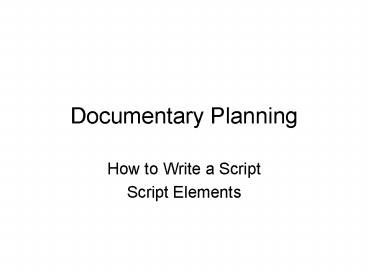Documentary Planning - PowerPoint PPT Presentation
Title:
Documentary Planning
Description:
Documentary Planning How to Write a Script Script Elements How to Use This PowerPoint As a planning guide: As you plan out your documentary, use these s. – PowerPoint PPT presentation
Number of Views:164
Avg rating:3.0/5.0
Title: Documentary Planning
1
Documentary Planning
- How to Write a Script
- Script Elements
2
How to Use This PowerPoint
- As a planning guide
- As you plan out your documentary, use these
slides. - Answer any questions in detail right on the slide.
3
How to Submit This PowerPoint
- Save the PowerPoint
- The file name should be LAST names.FIRST
name.class.Script planning. - Email it to jbomeisl_at_cfsd16.org or airdrop it.
4
Script Elements
- You will be planning
- Story
- Visuals
- Sound
5
Story Elements - Plot summary
- On this slide, briefly summarize your plot.
Remember a plot has a beginning, middle and
end. What is your main idea? How will you
present it?
6
Story Elements - Backstory
- What background that occurred before the start of
your film might the audience need to know?
7
Story Elements - the Beginning
- A good beginning
- Creates an audiovisual hook. What will be your
hook?
8
Story Elements - the Beginning
- A good beginning
- Establishes the core assertion of the film. What
is the purpose/thesis of your film? (Write it as
though you were writing a thesis statement for an
essay.)
9
Story Elements - the Beginning
- A good beginning
- Creates curiosity among the audience. How will
you do this?
10
Story Elements - Beginning
- A good beginning
- Shows change or the promise of change. What
change are you advocating?
11
Story Elements - Beginning
- A good beginning
- Creates the element of consequence - cause and
effect directs the audience and increases
understanding. What cause and effect might you
use?
12
The beginning Inciting incident
- Inciting Incident causes conflict, causes change
- What is YOUR inciting incident? (Note sometimes
this is your hook as well.)
13
Story Elements - the Middle - Common Issues
- Concept, idea, thought - each sequence is related
through common issues. What are the common issues?
14
Story Elements - the Middle - Opposing Viewpoints
- What are the opposing viewpoints you will use?
15
Story Elements - Middle - Settings
- Setting - use common locations or different
locations within a common, larger setting. What
settings will you use?
16
Story Elements - Middle - Mood
- Mood - can make sequences relate to each other -
comparison OR contrast. Can you get the audience
emotionally involved? What mood(s) will you
utilize?
17
Story Elements - Middle Pacing
- How will you pace your film? Linear? Non-linear
time? (See your notes from previous lessons.) - If non-linear Scriptwriter must know audience
well in order to use non-linear. Why will this
work for your audience?
18
Story Elements - The Middle Pacing
- Transitions - What ones will you use? Visual?
Sound?
19
Story Elements - The End
- The End Must be inevitable and unexpected. Which
type will you use? - Two types of ending
- Closed end - all questions and emotions raised in
story are satisfied. No doubt or question is
left. - Open end - leaves one or more questions
unanswered, some emotions unfulfilled. Does NOT
leave audience hanging, but offers alternatives
and choice.
20
Story Elements - POV
- Plot The Point of View (POV) determines the
narration. - Which will you use?
- First person POV is most common. Characters talk
in terms of I, film records their experiences
through their eyes. - Second person POV - narration directly addresses
audience as you- often used in television video
magazines and news stories - Third person POV - more common in classical
documentaries. Told from perspective of someone
unknown by audience, a god-like omnipresent
person.
21
Story Elements - POV
- Plot Point of View
- Who is telling the story to the audience?
22
Visual Elements - plan yours!
- Visual elements The Sequence - What type(s) of
sequences will you use? Describe them. When will
you use them?
23
Identify Plan Other Visual Elements you could
use
- The Montage
- Talking Heads
24
Identify Plan Other Visual Elements you could
use
- Archival film footage or photographs.
- Graphics
- Ranactment
25
Identify Plan Other Visual Elements you could
use
- Visual Metaphors Describe ones you might use.
- Special effects
26
Sound Elements - what will you use? Give examples
- Narrative commentary
- Voice over
- Talking heads
- Music
- Ambiance sound
- Sound effects
- Silence

